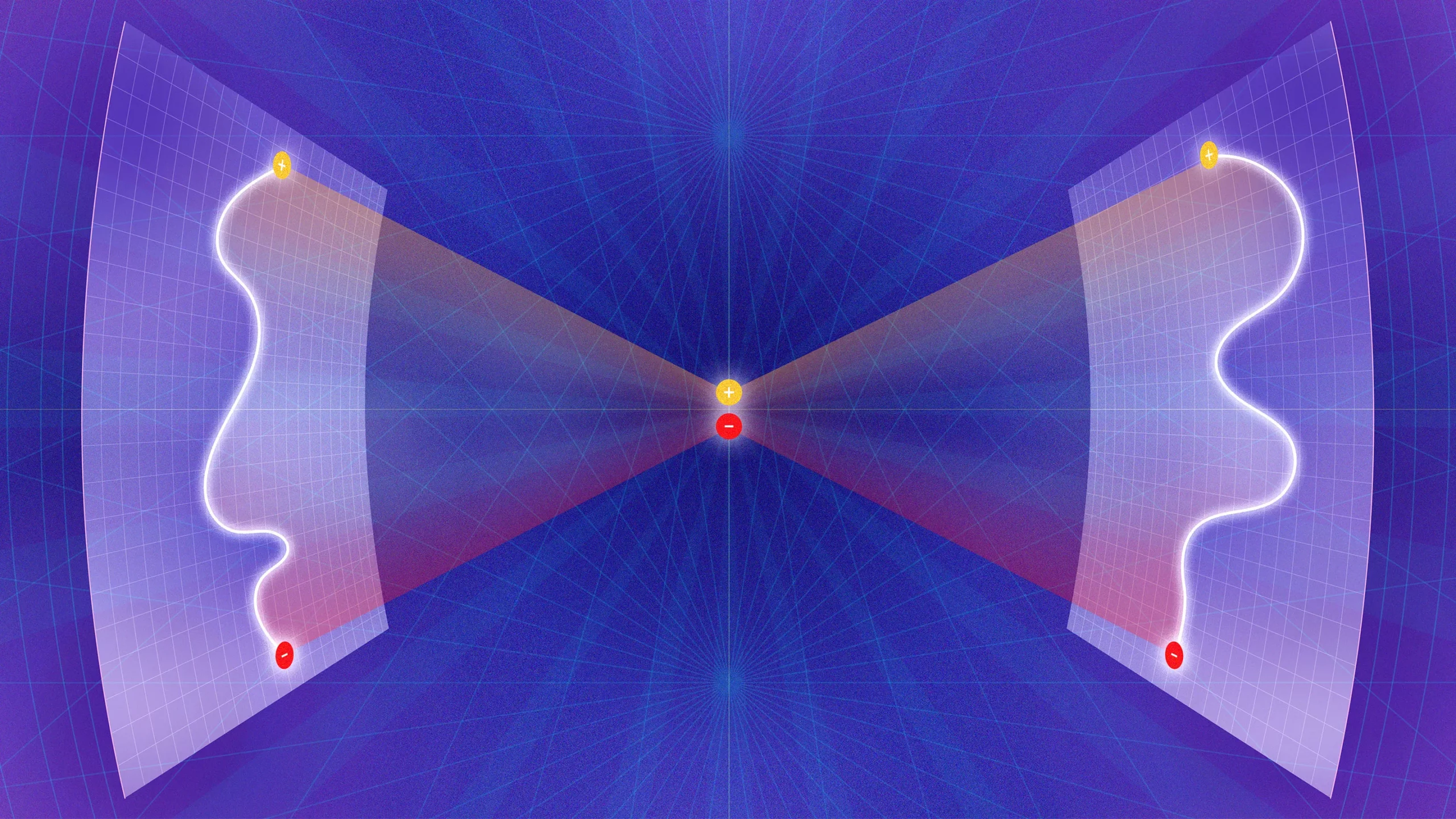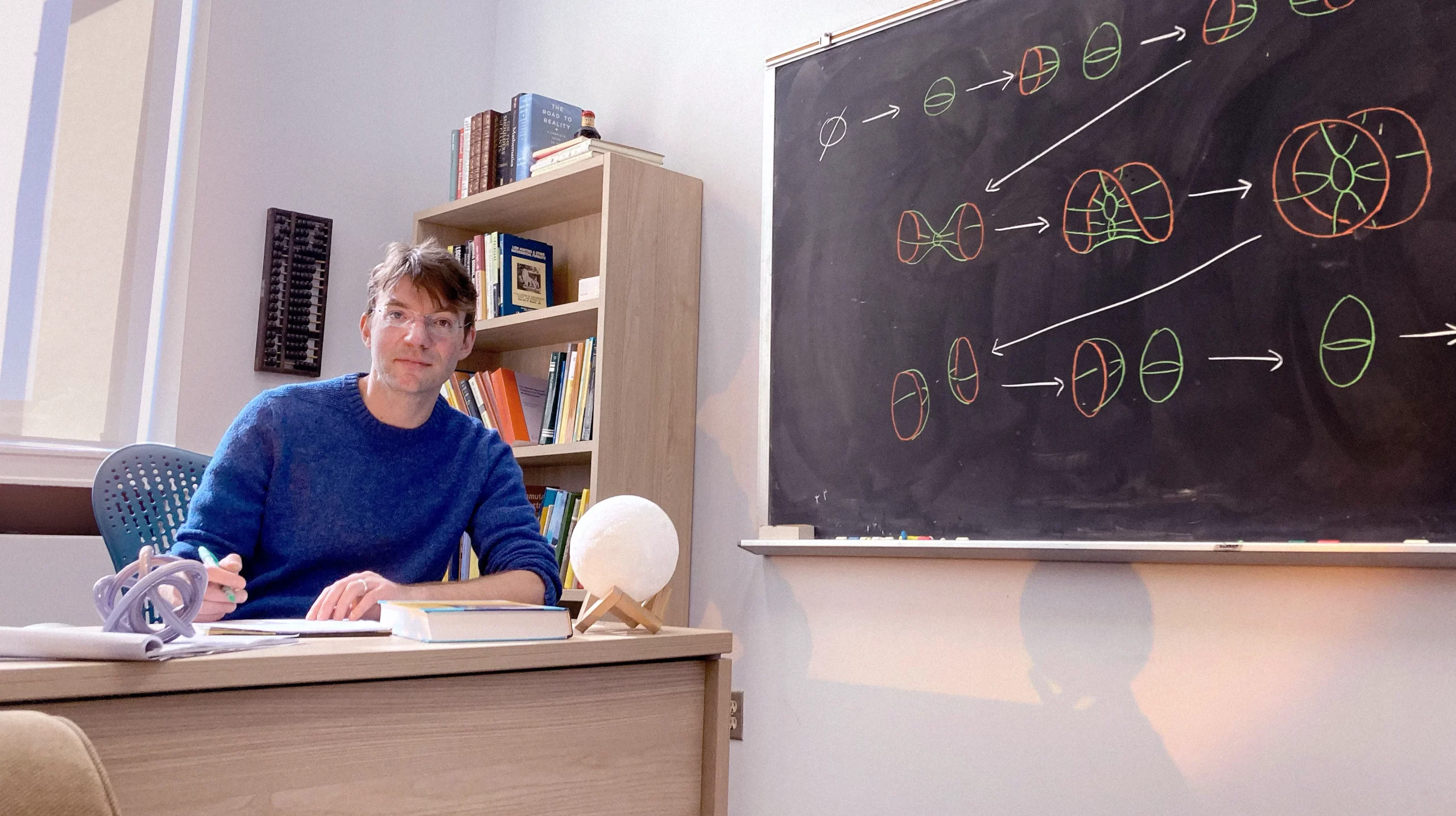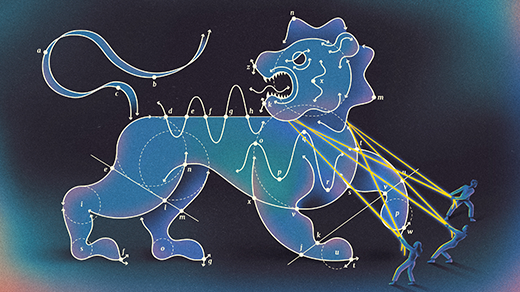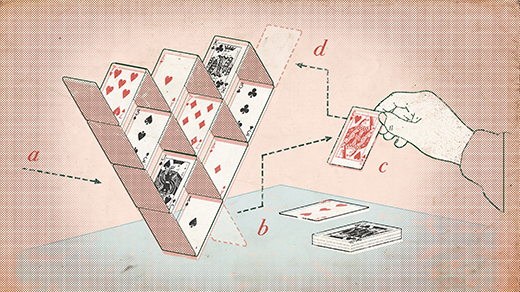A New Kind of Symmetry Shakes Up Physics

The symmetries of 20th-century physics were built on points. Higher symmetries are based on one-dimensional lines.
Samuel Velasco/Quanta Magazine
Introduction
It’s not an exaggeration to say that every major advance in physics for more than a century has turned on revelations about symmetry. It’s there at the dawn of general relativity, in the birth of the Standard Model, in the hunt for the Higgs.
For that reason, research across physics is now building to a crescendo. It was touched off by a 2014 paper, “Generalized Global Symmetries,” which demonstrated that the most important symmetries of 20th-century physics could be extended more broadly to apply in quantum field theory, the basic theoretical framework in which physicists work today.
This reformulation, which crystallized earlier work in the area, revealed that disparate observations physicists had made in the past 40 years were really manifestations of the same lurking symmetry. In doing so, it created an organizing principle that physicists could use to categorize and understand phenomena. “That’s really a stroke of genius,” said Nathaniel Craig, a physicist at the University of California, Santa Barbara.
The principle identified in the paper came to be known as “higher symmetries.” The name reflects the way the symmetries apply to higher-dimensional objects such as lines, rather than lower-dimensional objects such as particles at single points in space. By giving the symmetry a name and language and by identifying places it had been observed before, the paper prompted physicists to search for other places it might appear.
Physicists and mathematicians are collaborating to work out the mathematics of these new symmetries — and in some cases they’re discovering that the symmetries work like a one-way street, a notable contrast to all other symmetries in physics. At the same time, physicists are applying the symmetries to explain a wide range of questions, from the decay rate of certain particles to novel phase transitions like the fractional quantum Hall effect.
“By putting a different perspective on a known sort of physical problem, it just opened up a huge new area,” said Sakura Schafer-Nameki, a physicist at the University of Oxford.
Symmetry Matters
To understand why a paper that merely points out the breadth of lurking symmetries can make such a big impact, it helps to first understand how symmetry makes life easier for physicists. Symmetry means fewer details to keep track of. That’s true whether you’re doing high-energy physics or laying bathroom tile.
The symmetries of a bathroom tile are spatial symmetries — each can be rotated, flipped upside down or moved to a new spot. Spatial symmetries play an important simplifying role in physics too. They’re prominent in Einstein’s theory of space-time — and the fact that they pertain to our universe means physicists have one less thing to worry about.
“If you’re doing an experiment in a lab and you rotate it, that shouldn’t change your answer,” said Nathan Seiberg, a theoretical physicist at the Institute for Advanced Study in Princeton, New Jersey.
The symmetries that are most important in physics today are subtler than spatial symmetries, but they carry the same meaning: They’re constraints on the ways that you can transform something to ensure that it’s still the same.
In an epochal insight in 1915, the mathematician Emmy Noether formalized the relationship between symmetries and conservation laws. For example, symmetries in time — it doesn’t matter if you run your experiment today or tomorrow — mathematically imply the law of conservation of energy. Rotational symmetries lead to the law of conservation of angular momentum.
“Every conservation law is associated with a symmetry, and every symmetry is associated with a conservation law,” Seiberg said. “It’s well understood and it’s very deep.”
This is just one of the ways that symmetries help physicists understand the universe.
Physicists would like to create a taxonomy of physical systems, classifying like with like, in order to know when insights from one can be applied to another. Symmetries are a good organizing principle: All systems exhibiting the same symmetry go in the same bucket.
Furthermore, if physicists know a system possesses a given symmetry, they can avoid a lot of the mathematical work of describing how it behaves. The symmetries constrain the possible states of the system, which means they limit the potential answers to the complicated equations that characterize the system.
“Typically, some random physical equations are unsolvable, but if you have enough symmetry, then the symmetry constrains the possible answers. You can say the solution must be this because it’s the only symmetric thing,” said Theo Johnson-Freyd of the Perimeter Institute for Theoretical Physics in Waterloo, Canada.
Symmetries convey elegance, and their presence can be obvious in hindsight. But until physicists identify their influence, related phenomena can remain distinct. Which is what happened with a host of observations physicists made starting in the early 1970s.
Fields and Strings
The conservation laws and symmetries of 20th-century physics take pointlike particles as their primary objects. But in modern quantum field theories, quantum fields are the most basic objects, and particles are just fluctuations in these fields. And within these theories it’s often necessary to go beyond points and particles to think about one-dimensional lines, or strings (which are conceptually distinct from the strings in string theory).
In 1973, physicists described an experiment that involved placing a superconducting material between poles of a magnet. They observed that as they increased the strength of the magnetic field, particles arranged themselves along one-dimensional superconducting threads running between the magnetic poles.
The next year Kenneth Wilson identified strings — Wilson lines — in the setting of classical electromagnetism. Strings also appear in the way the strong force acts among quarks, which are the elementary particles that make up a proton. Separate a quark from its antiquark, and a string forms between them that pulls them back together.
The point is that strings play an important role in many areas of physics. At the same time, they’re mismatched to traditional conservation laws and symmetries, which are expressed in terms of particles.
“The modern thing is to say we’re not only interested in the properties of points; we’re interested in the properties of lines or strings, and there can also be conservation laws for them,” said Seiberg, who co-wrote the 2014 paper along with Davide Gaiotto of the Perimeter Institute, Anton Kapustin of the California Institute of Technology, and Brian Willett, who was at the time a postdoc at the Institute for Advanced Study.
The paper presented a way of measuring charge along a string and establishing that charge remains conserved as the system evolves, just as total charge is always conserved for particles. And the team did it by shifting their attention from the string itself.

Theo Johnson-Freyd, a mathematician at the Perimeter Institute for Theoretical Physics.
Brian I. Gillis
Seiberg and his colleagues imagined the one-dimensional string as being surrounded by a surface, a two-dimensional plane, so that it looked like a line drawn on a sheet of paper. Instead of measuring charge along the string, they described a method for measuring the total charge across the surface surrounding the string.
“The really new thing is you emphasize the charged object, and you think about [surfaces] that surround it,” Schafer-Nameki said.
The four authors then considered what happens to the surrounding surface as the system evolves. Maybe it warps or twists or otherwise changes from the completely flat surface they measured originally. Then they demonstrated that even as the surface deforms, the total charge along it remains the same.
That is, if you measure charge at every point on a piece of paper, then distort the paper and measure again, you’ll get the same number. You can say that charge is conserved along the surface, and since the surface is indexed to the string, you can say it’s conserved along the string, too — regardless of what kind of string you started with.
“The mechanics of a superconducting string and a strong-force string are completely different, yet the mathematics of these strings and the conservation [laws] are exactly the same,” Seiberg said. “That’s the beauty of this whole idea.”
Equivalent Surfaces
The suggestion that a surface remains the same — has the same charge — even after it’s deformed echoes concepts from the mathematical field of topology. In topology, mathematicians classify surfaces according to whether one can be deformed into the other without any ripping. According to this viewpoint, a perfect sphere and a lopsided ball are equivalent, since you can inflate the ball to get the sphere. But a sphere and an inner tube are not, as you’d have to gash the sphere to get the inner tube.
Similar thinking about equivalence applies to surfaces around strings — and by extension, the quantum field theories inside of which those surfaces are drawn, Seiberg and his co-authors wrote. They referred to their method of measuring charge on surfaces as a topological operator. The word “topological” conveys that sense of overlooking insignificant variations between a flat surface and a warped one. If you measure the charge on each, and it comes out the same, you know that the two systems can be smoothly deformed into each other.
Topology allows mathematicians to look past minor variations to focus on fundamental ways in which different shapes are the same. Similarly, higher symmetries provide physicists with a new way of indexing quantum systems, the authors concluded. Those systems may look completely different from each other, but in a deep way they might really obey the same rules. Higher symmetries can detect that — and by detecting it, they allow physicists to take knowledge about better-understood quantum systems and apply it to others.
“The development of all these symmetries is like developing a series of ID numbers for a quantum system,” said Shu-Heng Shao, a theoretical physicist at Stony Brook University. “Sometimes two seemingly unrelated quantum systems turn out to have the same set of symmetries, which suggests they might be the same quantum system.”
Despite these elegant insights about strings and symmetries in quantum field theories, the 2014 paper didn’t spell out any dramatic ways of applying them. Equipped with new symmetries, physicists might hope to be able to answer new questions — but at the time, higher symmetries were only immediately useful for re-characterizing things physicists already knew. Seiberg recalls being disappointed that they couldn’t do more than that.
“I remember going around thinking, ‘We need a killer app,’” he said.
From New Symmetries to New Mathematics
To write a killer app, you need a good programming language. In physics, mathematics is that language, explaining in a formal, rigorous way how symmetries work together. Following the landmark paper, mathematicians and physicists started by investigating how higher symmetries could be expressed in terms of objects called groups, which are the main mathematical structure used to describe symmetries.
A group encodes all the ways the symmetries of a shape or a system can be combined. It establishes the rules for how the symmetries operate and tells you what positions the system can end up in following symmetry transformations (and which positions, or states, can never occur).
Group encoding work is expressed in the language of algebra. In the same way that order matters when you’re solving an algebraic equation (dividing 4 by 2 is not the same as dividing 2 by 4), the algebraic structure of a group reveals how order matters when you’re applying symmetry transformations, including rotations.
“Understanding algebraic relationships between transformations is a precursor to any application,” said Clay Córdova of the University of Chicago. “You can’t understand how the world is constrained by rotations until you understand ‘What are rotations?’”
Merrill Sherman/Quanta Magazine
By investigating those relationships, two separate teams — one involving Córdova and Shao and one that includes researchers at Stony Brook and the University of Tokyo — discovered that even in realistic quantum systems, there are non-invertible symmetries that fail to conform to the group structure, a feature that every other important type of symmetry in physics fits into. Instead, these symmetries are described by related objects called categories which have more relaxed rules for how symmetries can be combined.
For example, in a group, every symmetry is required to have an inverse symmetry — an operation that undoes it and sends the object it acts on back to where it started. But in separate papers published last year, the two groups showed that some higher symmetries are non-invertible, meaning once you apply them to a system, you can’t get back to where you started.
This non-invertibility reflects the way that a higher symmetry can transform a quantum system into a superposition of states, in which it is probabilistically two things at once. From there, there’s no road back to the original system. To capture this more complicated way higher symmetries and non-invertible symmetries interact, researchers including Johnson-Freyd have developed a new mathematical object called a higher fusion category.
“It’s the mathematical edifice that describes the fusions and interactions of all these symmetries,” Córdova said. “It tells you all the algebraic possibilities for how they can interact.”
Higher fusion categories help to define the non-invertible symmetries that are mathematically possible, but they don’t tell you which symmetries are useful in specific physical situations. They establish the parameters of a hunt on which physicists then embark.
“As a physicist the exciting thing is the physics we get out of it. It shouldn’t just be math for the sake of math,” Schafer-Nameki said.
Early Applications
Equipped with higher symmetries, physicists are also reevaluating old cases in light of new evidence.
For example, in the 1960s physicists noticed a discrepancy in the decay rate of a particle called the pion. Theoretical calculations said it should be one thing, experimental observations said another. In 1969, two papers seemed to resolve the tension by showing that the quantum field theory which governs pion decay does not actually possess a symmetry that physicists thought it did. Without that symmetry, the discrepancy disappeared.
But last May, three physicists proved that the 1969 verdict was only half the story. It wasn’t just that the presupposed symmetry wasn’t there — it was that higher symmetries were. And when those symmetries were incorporated into the theoretical picture, the predicted and observed decay rates matched exactly.
“We can reinterpret this mystery of the pion decay not in terms of the absence of symmetry but in terms of the presence of a new kind of symmetry,” said Shao, a co-author of the paper.
Similar reexamination has taken place in condensed matter physics. Phase transitions occur when a physical system switches from one state of matter to another. At a formal level, physicists describe those changes in terms of symmetries being broken: Symmetries that pertained in one phase no longer apply in the next.
But not all phases have been neatly described by symmetry-breaking. One, called the fractional quantum Hall effect, involves the spontaneous reorganization of electrons, but without any apparent symmetry being broken. This made it an uncomfortable outlier within the theory of phase transitions. That is, until a paper in 2018 by Xiao-Gang Wen of the Massachusetts Institute of Technology helped establish that the quantum Hall effect does in fact break a symmetry — just not a traditional one.
“You can think of [it] as symmetry-breaking if you generalize your notion of symmetry,” said Ashvin Vishwinath of Harvard University.
These early applications of higher and non-invertible symmetries — to the pion decay rate, and to the understanding of the fractional quantum Hall effect — are modest compared to what physicists anticipate.
In condensed matter physics, researchers hope that higher and non-invertible symmetries will help them with the fundamental task of identifying and classifying all possible phases of matter. And in particle physics, researchers are looking to higher symmetries to assist with one of the biggest open questions of all: what principles organize physics beyond the Standard Model.
“I want to get the Standard Model out of a consistent theory of quantum gravity, and these symmetries play a critical role,” said Mirjam Cvetic of the University of Pennsylvania.
It will take a while to fully reorient physics around an expanded understanding of symmetry and a broader notion of what makes systems the same. That so many physicists and mathematicians are joining in the effort suggests they think it will be worth it.
“I have not yet seen shocking results that we didn’t know before, but I have no doubt it’s quite likely this will happen, because this is clearly a much better way of thinking about the problem,” Seiberg said.
Correction: April 18, 2023
Rotational symmetries imply the conservation of angular momentum, not just momentum, as the article originally stated.



